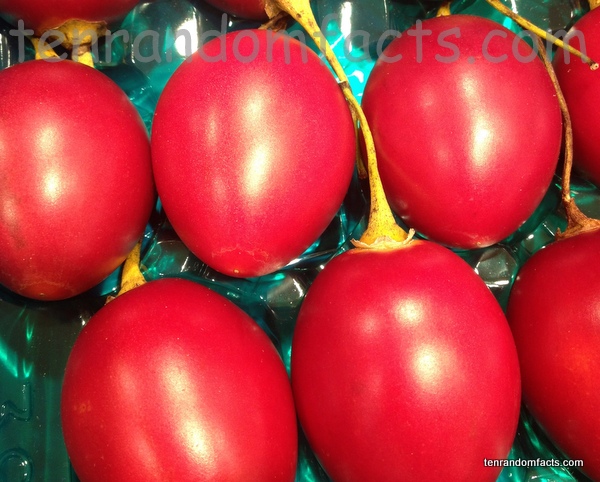Meet the long lost cousin of the tomato – the tamarillo!
- Tamarillos are a variety of fruit, comparable to the tomato, and they are native to South America.
- New Zealanders gave the name ‘tamarillo’ to the ‘tree tomato’ fruit, a name it is also known by, in 1967 for commercial purposes, and the fruit is also called ‘tamamoro’, ‘tomate dulce’, ‘tomate granadilla’ and ‘tomate de árbol’ among other names.
- The tamarillo grows on the plant with the scientific name Solanum betaceum, and it is from the family Solanaceae, the family of nightshades.
- Tamarillos are somewhat ovoid in shape, and typically reach a length of 4 to 10 centimetres (1.6 to 4 inches) and have a diameter of 3.8 to 5 centimetres (1.5 to 2 inches).
- The skin of tamarillos can be yellow, red, orange, or purple, while the flesh is often a similar colour to the skin but it sometimes differs.
- Tamarallos grow on a tree with a height generally between 3 to 5.5 metres (10 to 18 feet); and a single tree can produce 20 to 30 kilograms (44 to 66 pounds) of fruit each year.
- A tamarillo’s flavour varies with the colour, with red variants generally having a tart flavour, while the yellow varieties are typically sweet, having a flavour combination of kiwi or passion fruit and tomato.
- While tamarillos can be eaten raw, often with a utensil that is used to spoon out the flesh, the tough bitter skin is usually left uneaten unless cooked; and the fruit is also popularly made into spreads, stews, curries and other sauces.
- Tamarillos are very high in vitamin C and are good sources of vitamins A and E, as well as iron and pyridoxine.
- Tamarillos have been cultivated in parts of Asia and Africa, and they have also been commercially grown in New Zealand since the 1920s, after which demand increased during World War II, due to the fruit’s vitamin C content.
Bibliography:
History, NZ Tamarillo Growers Association, 2008, http://www.tamarillo.com/history/
Tamarillo, 2016, Wikipedia, https://en.wikipedia.org/wiki/Tamarillo
https://hort.purdue.edu/newcrop/morton/tree_tomato.html






